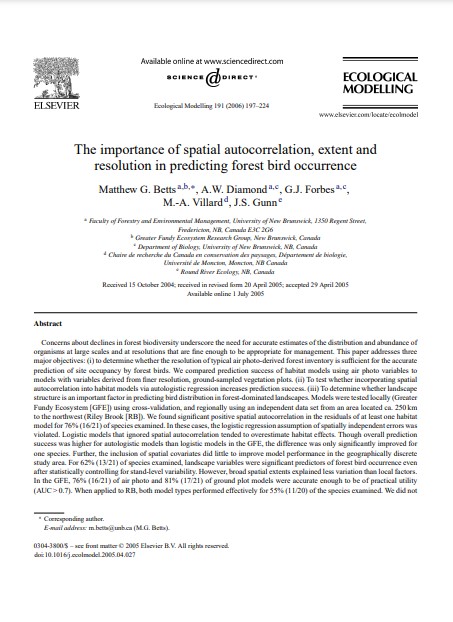The importance of spatial autocorrelation, extent and resolution in predicting forest bird occurrence
Bosque Modelo:
Fundy
Temática:
Gestión forestal
Tipo de documento:
Artículo científico
Resumen
Concerns about declines in forest biodiversity underscore the need for accurate estimates of the distribution and abundance of organisms at large scales and at resolutions that are fine enough to be appropriate for management. This paper addresses three major objectives: (i) to determine whether the resolution of typical air photo-derived forest inventory is sufficient for the accurate prediction of site occupancy by forest birds. We compared prediction success of habitat models using air photo variables to models with variables derived from finer resolution, ground-sampled vegetation plots. (ii) To test whether incorporating spatial autocorrelation into habitat models via autologistic regression increases prediction success. (iii) To determine whether landscape structure is an important factor in predicting bird distribution in forest-dominated landscapes. Models were tested locally (Greater Fundy Ecosystem [GFE]) using cross-validation, and regionally using an independent data set from an area located ca. 250 km to the northwest (Riley Brook [RB]). We found significant positive spatial autocorrelation in the residuals of at least one habitat model for 76% (16/21) of species examined. In these cases, the logistic regression assumption of spatially independent errors was violated. Logistic models that ignored spatial autocorrelation tended to overestimate habitat effects. Though overall prediction success was higher for autologistic models than logistic models in the GFE, the difference was only significantly improved for one species. Further, the inclusion of spatial covariates did little to improve model performance in the geographically discrete study area. For 62% (13/21) of species examined, landscape variables were significant predictors of forest bird occurrence even after statistically controlling for stand-level variability. However, broad spatial extents explained less variation than local factors. In the GFE, 76% (16/21) of air photo and 81% (17/21) of ground plot models were accurate enough to be of practical utility (AUC > 0.7). When applied to RB, both model types performed effectively for 55% (11/20) of the species examined. We did notdetect an overall difference in prediction success between air photo and ground plot models in either study area. We conclude that air photo data are as effective as fine resolution vegetation data for predicting site occupancy for the majority of species in this study. These models will be of use to forest managers who are interested in mapping species distributions under various timber harvest scenarios, and to protected areas planners attempting to optimize reserve function.
Información Bibliográfica
Autor:
Betts, MG, AW Diamond, GJ Forbes, MA Villard and JS Gunne.
Revista:
Ecological Modelling
Año:
2006
N°:
-
País :
Canadá
Páginas:
197 - 224
Volumen:
191
Idioma:
Ingles
Palabras claves
Bird–habitat relationships; Spatial autocorrelation; Autologistic regression; Geographic Information Systems; Spatial resolution and extent; Model performance





